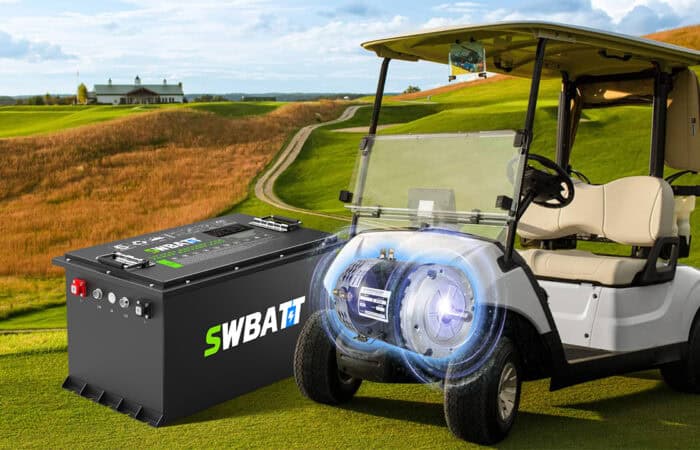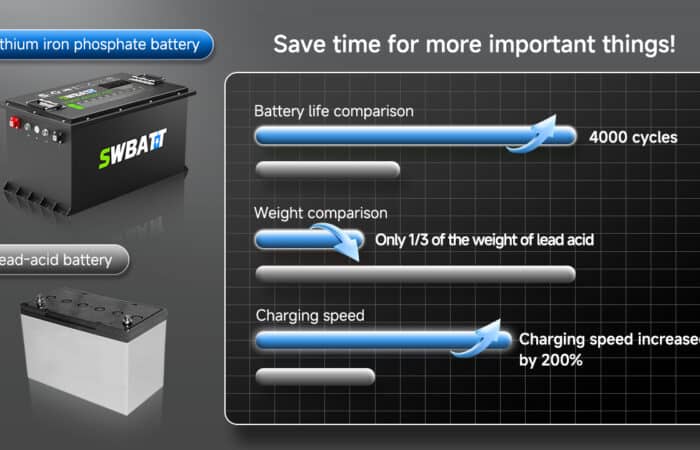Converting your golf cart to lithium batteries and adding a high-speed motor can unlock significant performance gains – increased speed, torque, and range. However, this combination can also introduce potential problems if not handled correctly. This guide addresses the common issues when pairing lithium batteries with high-speed golf cart motors, providing practical solutions and expert advice. We’ll focus on the technical aspects, helping you understand why these problems occur and how to prevent them.

The core issue stems from the high current demands of high-speed golf cart motors, particularly series-wound DC motors, which are popular for their high starting torque. These motors can draw substantial current, especially under acceleration and heavy loads. While lithium batteries offer numerous advantages over lead acid (higher energy density, lighter weight, longer lifespan), they also have specific characteristics that must be considered.
1. High-Speed Golf Cart Motors: Defining “High-Speed”
“High-speed” in the context of golf cart motors is relative. A stock golf cart motor might have a top speed of 12-15 mph. Upgraded motors can achieve speeds of 20-25+ mph, and some specialized motors can go even faster. This increased speed comes with increased power demands. Key parameters to consider:
- RPM (Revolutions Per Minute): Higher RPM generally means higher speed.
- Wattage/Horsepower: A higher wattage or horsepower rating indicates a more powerful motor.
- Current Draw (Amps): This is the critical factor. A stock motor might continuously draw 50-100 amps, while a high-speed motor can quickly draw 150-200+ amps or even higher peak currents. This is where problems often arise.
2. Lithium Battery Voltage Drop (and Why It Matters)
Unlike lead-acid batteries, which exhibit a significant voltage drop as they discharge, lithium iron phosphate (LiFePO4) batteries – the most common type used in golf carts – maintain a relatively stable voltage throughout most of their discharge cycle. However, even LiFePO4 batteries experience some voltage drop under heavy load. This is due to internal resistance within the battery cells and connections.
- Excessive Voltage Drop: If the voltage drops too low, the Battery Management System (BMS) can shut down the battery to protect it from damage (under-voltage protection). This can also cause the motor controller to malfunction or reduce performance.
- Source: Battery University explains voltage drop and internal resistance in detail: https://batteryuniversity.com/article/bu-202-internal-resistance
3. The Crucial Role of the Battery Management System (BMS)
The BMS is the “brain” of a lithium battery pack. It monitors voltage, current, temperature, and other parameters to ensure safe and optimal operation. Key BMS protections relevant to high-speed motors include:
- Over-Current Protection (OCP): Limits the maximum current drawn from the battery. This is crucial for preventing damage from excessive current draw.
- Under-Voltage Protection (UVP): This feature shuts down the battery if the voltage drops below a safe threshold, preventing over-discharge.
- Over-Temperature Protection (OTP): This feature shuts down the battery if it gets too hot. A high current draw generates heat.
- Short-Circuit Protection (SCP): Protects against short circuits.
4. Motor Controller Compatibility
The motor controller is responsible for regulating the power delivered to the motor. It’s essential to ensure the motor controller is compatible with:
* Lithium Battery Voltage: The controller must be rated for the nominal voltage of the lithium battery pack (e.g., 48V).
* High Current Demands: The controller must be able to handle the high-speed motor’s peak and continuous current draw
* Lithium Battery Discharge Profile: Some older controllers designed for lead-acid batteries may not work optimally with the flatter discharge curve of lithium batteries.
Golf Cart Lithium Battery Troubleshooting Guide
BMS Shutdown (Battery Turns Off)
Possible Causes: Undersized battery (low capacity/C-rating); Excessive current draw; Low voltage cutoff triggered; Over-temperature; Faulty BMS.
Решения: Upgrade to a higher-capacity battery with a higher C-rating; Check motor and controller specifications; Verify BMS settings; Ensure proper cooling; Inspect wiring and connections.
Reduced Speed/Power
Possible Causes: Voltage drop under load; Undersized battery; Motor controller limitations; Incorrect motor/controller settings.
Решения: Use a battery with a higher C-rating; Check motor controller compatibility and settings; Upgrade wiring if necessary.
Motor Overheating
Possible Causes: Excessive current draw; Inadequate cooling; Motor controller issues; Incorrect gear ratio.
Решения: Check motor specifications; Improve cooling (add a fan, ensure proper ventilation); Verify motor controller settings; Adjust gear ratio if necessary; Consult a motor specialist.
Battery Draining Quickly
Possible Causes: high current draw; inefficient motor/controller; parasitic loads (accessories draining power when the cart is off); battery degradation.
Решения: Optimize driving habits; check motor and controller efficiency; identify and eliminate parasitic loads; test battery capacity.
Charger Issues
Possible Causes: Incompatible charger, incorrect charger settings, or faulty charger.
Решения: Use a charger specifically designed for LiFePO4 batteries; verify charger voltage and current settings; test with a known-good charger.
Controller Issues
Possible Causes: Incompatible controller, incorrect controller settings, or faulty controller.
Решения: Make sure the controller is compatible with Lithium batteries and rated for the motor’s voltage and current; verify settings; consult with a professional to diagnose the controller.
Voltage Sag
Possible Causes: improperly installed DC-DC Converter, incorrect wiring, or battery issues.
Решения: Ensure the converter is correctly installed. If you’re not experienced with electronics, consult a professional.
Choosing the Right Components: A Step-by-Step Guide
Determine Your Motor’s Current Requirements: Consult the specifications (data sheet or manufacturer’s website) to find its continuous and peak current draw.
- Select a Battery with Sufficient Capacity (Ah) and Discharge Rate (C-rating): Capacity (Ah) Determines how long the battery will last on a single charge. Consider your typical driving distance and frequency of charging.
- C-Rating: Determines the maximum continuous current the battery can safely deliver. Use the formula from the previous response to calculate the required C-rating. Always choose a battery with a C rating that meets or exceeds the motor’s peak current draw.
Choose a Compatible Motor Controller: Ensure the controller is rated for the voltage and current of your chosen battery and motor.
Verify BMS Specifications: Make sure the BMS can handle the peak current draw of the motor and has appropriate protection settings.
Use a Lithium-Specific Charger: Never use a lead-acid charger with a lithium battery.
Consider a DC-DC Converter: If you need to run 12V accessories (lights, radio, etc.) from a higher-voltage battery pack (e.g., 48V), use a DC-DC converter to decrease the voltage. This prevents damage to your accessories.
Proper Wiring and Connections: Use appropriately sized wiring and high-quality connectors to handle the current. Poor connections can cause voltage drop and overheating.
Discover Advanced Lithium Battery Solutions
Explore SWBATT‘s innovative LifePO4 batteries for electric vehicles, energy storage, and more. Tailored solutions to meet your energy needs with efficiency and sustainability.
При переводе гольф-кара на литиевые батареи с высокоскоростным двигателем может возникнуть несколько проблем. Давайте рассмотрим наиболее распространенные проблемы и способы их решения:
Несовпадение напряжений и совместимость
Высокоскоростные двигатели часто требуют более высокого напряжения, чем могут обеспечить традиционные свинцово-кислотные батареи. Если напряжение литиевой батареи не соответствует требованиям двигателя, могут возникнуть проблемы с производительностью или даже повреждения.
Решение: Тщательно подберите литиевую батарею с правильным номинальным напряжением и убедитесь, что она совместима с двигателем. Консультация с профессионалом поможет избежать проблем с совместимостью.
Проблемы системы управления аккумулятором (BMS)
Система управления аккумулятором (BMS) обеспечивает безопасную и эффективную работу литиевой батареи. Однако неправильная интеграция BMS с высокоскоростным двигателем может привести к проблемам с производительностью.
Решение: Выберите BMS, разработанную специально для вашего двигателя и аккумуляторной системы. Это обеспечивает сбалансированное распределение энергии и предотвращает перегрев или сокращение срока службы батареи.
Перегрев двигателей
Высокоскоростные двигатели потребляют больше энергии, что может привести к чрезмерному нагреву. Если двигатель перегревается, это может привести к снижению производительности и потенциальному повреждению.
Решение: Обеспечьте адекватную вентиляцию и системы охлаждения, чтобы предотвратить перегрев. Решение по управлению тепловыделением поможет сохранить оптимальную производительность и продлить срок службы двигателя.

Сложности установки и модернизация старых моделей
Переход на литиевые батареи в старых гольф-карах может вызвать сложности при установке. Многие старые модели не были разработаны с учетом современных литиевых технологий, что может привести к проблемам при модернизации.
Общие проблемы при установке:
Несовместимые системы проводки: Старые системы электропроводки могут не справиться с требованиями к мощности литиевых батарей, что может привести к потенциальным угрозам безопасности, таким как перегрев или короткое замыкание.
Ограничения пространства: Литиевые батареи могут потребовать другой конфигурации, а место в старых тележках может быть ограничено.
Структурные модификации: Будьте готовы к возможным изменениям в распределении веса и точках крепления, так как их может потребоваться отрегулировать для установки литиевых батарей. Эта осведомленность поможет вам эффективно спланировать процесс переоборудования.
Решение: Для успешной установки необходимо провести подробную оценку электрической системы и физического пространства вашей тележки. Эта уверенность позволит вам продолжить преобразование.
Устранение неисправностей и техническое обслуживание литиевых гольф-каров
После переоборудования гольф-кара, работающего на литиевом топливе, требуется постоянный уход. Могут возникнуть такие распространенные проблемы, как уменьшение дальности хода, перебои в подаче электроэнергии или трудности с зарядкой.
Советы по устранению неполадок:
Проверьте все соединения: Ослабленные или корродированные соединения могут привести к потере питания.
Проверьте состояние батареи: Ищите признаки дисбаланса или износа, которые могут снизить эффективность.
Проверьте систему зарядки: Убедитесь, что зарядное устройство совместимо с литиевыми батареями и выдает правильное напряжение и ток.
Рекомендации по обслуживанию литиевых батарей
Литиевые батареи требуют иных методов обслуживания, чем свинцово-кислотные. Например, литиевые батареи не нуждаются в доливке воды, но требуют периодической балансировки элементов для обеспечения равномерного заряда и разряда.
Текущее обслуживание включает в себя:
Балансировка элементов батареи: Это позволяет повысить эффективность работы и продлить срок службы батареи.
Избегайте глубокой разрядки: Литиевые батареи не должны быть полностью разряженным; частичная зарядка помогает сохранить здоровье батареи.
Обновления BMS: Регулярно обновляйте программное обеспечение BMS для обеспечения оптимального управления батареей.
Анализ затрат и выгод при конверсии лития
Хотя первоначальные затраты на переоборудование литиевых батарей могут быть высокими, долгосрочные преимущества часто перевешивают инвестиции. К преимуществам относятся снижение затрат на обслуживание, увеличение срока службы батареи и повышение производительности.
Стоимость:
Первоначальные расходы: Стоимость литиевых батарей, контроллеров и установки.
Долгосрочная экономия: Снижение затрат на обслуживание и сокращение числа замен батарей.
Опыт пользователей часто показывает, что, несмотря на первоначальные затраты на преобразование, возврат инвестиций оказывается значительным благодаря улучшению производительности и снижению затрат на обслуживание.
Заключение: Повышение производительности гольф-кара с помощью литиевых батарей и высокоскоростных двигателей
Переход вашего гольф-кара на систему литиевых батарей в паре с высокоскоростным двигателем может значительно повысить его производительность. Однако к процессу преобразования необходимо подходить с тщательным планированием и учетом потенциальных проблем, таких как несоответствие напряжения, интеграция BMS и перегрев.
При должной подготовке и профессиональной помощи вы сможете насладиться многочисленными преимуществами этой модернизации, включая повышенную скорость, увеличенный срок службы аккумулятора и ускоренную зарядку. Следуя этим рекомендациям и советам по устранению неполадок, вы сможете обеспечить успешный и плавный переход на высокоскоростной гольф-кар с литиевым питанием.
Примите будущее технологии гольф-каров: Литиевые батареи представляют собой следующий шаг в производительности гольф-каров, предлагая передовое решение для пользователей, стремящихся максимально увеличить скорость, эффективность и надежность своих машин.
Frequently Asked Questions (FAQs)
- Q: Why does my golf cart shut down when I accelerate hard with a lithium battery and high-speed motor?
- A: This is likely due to the BMS’s over-current protection (OCP) or under-voltage protection (UVP) being triggered. The high current draw of the motor is either exceeding the battery’s capabilities or causing a significant voltage drop. Search Intent: “Golf cart lithium battery shuts down acceleration.”
- Q: Can I use my old lead-acid charger with my new lithium battery?
- A: No. Lithium batteries require a specific charging profile that lead-acid chargers do not provide. Using the wrong charger can damage the battery and create a safety hazard. Search Intent: “Charge lithium golf cart battery with lead acid charger.”
- Q: What C-rating do I need for my lithium golf cart battery?
- A: The required C-rating depends on your motor’s peak current draw. Calculate it using the earlier formula, and always choose a battery with a C-rating that meets or exceeds that value. Search Intent: “golf cart lithium battery C rating”
- Q: My lithium golf cart battery is losing range quickly. What could be the problem?
- A: Several factors could contribute to reduced range, including increased resistance in the system, an inefficient motor or controller, and issues with the battery.
Conclusion:
Successfully upgrading your golf cart with a lithium battery и a high-speed motor requires careful planning and component selection. Understanding the interplay between voltage, current, the BMS, and the motor controller is crucial for avoiding common problems like voltage drop and BMS shutdowns. By following the guidelines in this article and consulting with experienced professionals when needed, you can enjoy the benefits of both lithium power and enhanced speed safely and reliably. Contact SWBATT today for expert advice and customized lithium battery solutions for your golf cart.






